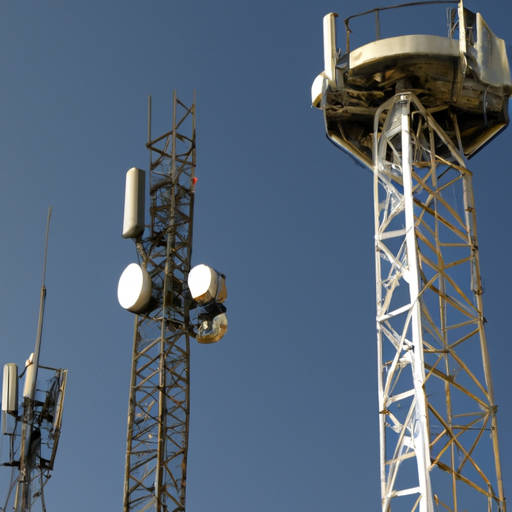If you’re wondering whether the signal booster/antenna is compatible with your mobile hotspot device, look no further. This article is here to provide you with all the information you need. We understand how important it is to have a reliable and strong signal for your mobile hotspot, especially when you rely on it for work, entertainment, or staying connected while on the go. So, let’s dive into the compatibility of signal boosters/antennas with your mobile hotspot device and find the perfect solution for you.
What is a signal booster/antenna?
Definition of signal booster/antenna
A signal booster/antenna is a device that is used to enhance and strengthen the signal reception of mobile hotspot devices. It works by amplifying the existing signal from the network provider and transmitting it to the mobile hotspot device, resulting in improved signal strength and coverage.
Stay Connected Anywhere with Our Favorite Portable WiFi Mobile Hotspot!
Experience seamless connectivity on-the-go with our portable WiFi mobile hotspot. Stay connected with high-speed internet wherever you are.
Stay connected on-the-go! Get your portable WiFi mobile hotspot today and enjoy reliable internet wherever you travel.
How signal boosters/antennas work
Signal boosters/antennas work by capturing the weak cellular signals, amplifying them, and then retransmitting them to the mobile hotspot device. The booster/antenna consists of an external antenna that is positioned to receive the best quality signal and an amplifier that increases the signal strength. The amplified signal is then transmitted to the mobile hotspot device through a cable or wirelessly, depending on the type of booster/antenna. This process helps to reduce signal loss, interference, and improve the overall performance of the mobile hotspot device.
Understanding mobile hotspot devices
Definition of a mobile hotspot
A mobile hotspot is a portable device that allows you to connect to the internet by using cellular data. It acts as a router, creating a Wi-Fi network to which other devices can connect and access the internet. Mobile hotspots are particularly useful in situations where there is no Wi-Fi access, such as when travelling or in remote locations.
Purpose and benefits of using a mobile hotspot
The primary purpose of using a mobile hotspot is to provide internet connectivity to multiple devices simultaneously. With a mobile hotspot, you can connect your smartphones, tablets, laptops, and other Wi-Fi-enabled devices to the internet wherever you go. This flexibility allows you to stay connected, work, or browse the web even in areas with limited or no Wi-Fi coverage. Mobile hotspots also provide a secure connection, as they can be password-protected, ensuring that only authorized users can access the network.
The importance of signal strength for mobile hotspot devices
Why signal strength is crucial for a mobile hotspot
Signal strength plays a vital role in the performance of a mobile hotspot device. A stronger signal ensures faster and more reliable connection speeds, reduced latency, and fewer interruptions during data transfer. It enables smoother streaming of videos, faster downloads, and seamless browsing of websites. In areas with weak or low signal strength, the performance of the mobile hotspot can be severely impacted, leading to slower speeds, dropped connections, and overall frustration.
Effect of low signal strength on hotspot performance
Low signal strength can significantly impact the performance of a mobile hotspot device. When the signal is weak, the hotspot device may struggle to connect to the network or maintain a stable connection. This can result in slower internet speeds, increased latency, and a poor browsing experience. Additionally, low signal strength can lead to frequent disconnections, disrupting ongoing downloads, video streaming, or other online activities. To overcome these issues and improve the overall performance of the mobile hotspot, a signal booster/antenna can be a valuable addition.
Types of signal boosters/antennas
Different types of signal boosters/antennas available
There are various types of signal boosters/antennas available in the market, each designed to cater to different needs and scenarios. These include:
- Indoor signal boosters: These boosters are designed to enhance the signal strength within a specific area, such as a room or small office. They usually consist of an external antenna, an amplifier, and an internal antenna.
- Outdoor signal boosters: Outdoor boosters are designed to improve signal strength in larger areas, such as homes, commercial buildings, or large outdoor spaces. They typically have a more powerful amplifier and larger external antennas to capture and boost the signal over a wider range.
- Vehicle signal boosters: These boosters are specifically designed for use in vehicles, such as cars, RVs, or boats. They help improve signal reception while on the move and can be useful for people who rely on mobile hotspots for internet access during travel.
Which type of booster/antenna is suitable for a mobile hotspot
The type of booster/antenna suitable for a mobile hotspot depends on various factors, including the specific requirements, coverage area, and the user’s mobility. For individuals who primarily use their mobile hotspot indoors or in a small area, an indoor signal booster may be sufficient. On the other hand, those who require coverage in larger spaces or frequently travel may benefit from outdoor or vehicle signal boosters. It is essential to assess the coverage needs and usage patterns to determine the most suitable type of booster/antenna for a mobile hotspot device.

Factors to consider before purchasing a signal booster/antenna
Compatibility with mobile hotspot devices
Before purchasing a signal booster/antenna, it is crucial to ensure compatibility with the mobile hotspot device. While most boosters/antennas are designed to work with a wide range of devices, it is still essential to check if they are compatible with the specific model and brand of the mobile hotspot. This information can usually be found in the product specifications or by consulting the manufacturer’s website or customer support.
Frequency bands supported by the booster/antenna
Mobile networks operate on different frequency bands, and it’s important to ensure that the booster/antenna supports the frequency bands used by your network provider. Verify the frequency bands supported by the signal booster/antenna and cross-reference them with the ones used by your mobile hotspot device. This information can typically be found in the product description or specifications provided by the manufacturer.
RF connector compatibility
Signal boosters/antennas often require connections with the mobile hotspot device through RF connectors. Before purchasing a booster/antenna, it is necessary to ensure that the connector type and compatibility match with the mobile hotspot device. Common connector types include SMA, TS9, MCX, and FME, among others. Verification of connector compatibility can usually be done by referring to the device’s specifications or contacting customer support.
Power source requirements
Some signal boosters/antennas require a direct power source to operate, while others can utilize power over the coaxial cable connection. Consider the availability of a power source in the installation area and verify if the booster/antenna requires one. This information can generally be found in the product description or user manual provided with the booster/antenna.
Physical installation requirements
Signal boosters/antennas may have specific installation requirements that need to be considered before purchasing. Some boosters/antennas can be easily self-installed, while others may require professional installation due to complex setup procedures or external antenna placements. Assess the installation options available and choose a booster/antenna that aligns with your requirements and capabilities.
Determining compatibility between signal booster/antenna and mobile hotspot device
Check device specifications and requirements
To determine compatibility between a signal booster/antenna and a mobile hotspot device, start by checking the specifications and requirements provided by both devices. Verify if the frequency bands, connector types, and power source requirements match. This step will help eliminate any potential compatibility issues and ensure a seamless integration between the booster/antenna and the mobile hotspot device.
Research compatibility with specific mobile hotspot models
If the specifications or requirements do not explicitly state the compatibility, conducting additional research can be beneficial. Search for information or user experiences regarding the specific mobile hotspot model and the signal booster/antenna under consideration. Online forums, product reviews, and customer testimonials can provide insights into the compatibility and performance of different combinations.
Seek professional advice or consult customer support
For individuals who are unsure about compatibility or have unique requirements, seeking advice from professionals or contacting customer support can be a helpful step. Professionals in the field can provide expert guidance and recommendations based on your specific needs. Customer support teams of booster/antenna manufacturers can also provide clarification or assistance in determining compatibility and resolving any queries or concerns.

Benefits of using a signal booster/antenna with a mobile hotspot device
Improved signal strength and coverage
The primary benefit of using a signal booster/antenna with a mobile hotspot device is the significant improvement in signal strength and coverage. By capturing and amplifying the weak cellular signals, the booster/antenna ensures a stronger and more reliable connection to the network. This allows for enhanced performance and connectivity in areas with low signal strength, ultimately leading to a better user experience.
Enhanced data transfer speeds
With a stronger signal strength, the data transfer speeds of the mobile hotspot device are greatly enhanced. Faster download and upload speeds enable smoother streaming of high-definition videos, faster file transfers, and quicker loading times for websites and applications. The boost in data transfer speeds can significantly improve productivity and overall satisfaction when using a mobile hotspot.
Stable and reliable internet connection
A signal booster/antenna helps stabilize the internet connection of a mobile hotspot device. By minimizing signal loss, interference, and disruptions, the booster/antenna ensures a more consistent and reliable connection. This is particularly important in situations where maintaining a steady connection is crucial, such as during video conferences, online gaming, or critical work-related tasks.
Expanded network coverage area
One of the advantages of using a signal booster/antenna is the ability to expand the coverage area of the mobile hotspot device. The booster/antenna can capture and amplify signals from a wider range, allowing the hotspot device to reach areas where the signal strength may have been weak or non-existent. This is especially beneficial when using a mobile hotspot in large homes, offices, or outdoor spaces, as it provides extended coverage and enables connectivity in previously inaccessible areas.
Installation and setup process
Step-by-step guide for installing a signal booster/antenna
Installing a signal booster/antenna can be done by following these general steps:
- Identify an optimal location for the external antenna. This is usually in a high and unobstructed area where the best signal reception can be achieved.
- Mount the external antenna securely in the identified location.
- Connect the external antenna to the signal booster/antenna using the provided cables or connectors.
- Position the internal antenna in a central location within the area you want to improve signal coverage.
- Connect the internal antenna to the signal booster/antenna using the provided cables or connectors.
- If necessary, connect the power source to the booster/antenna.
- Power on the booster/antenna and wait for it to establish a connection with the mobile hotspot device.
Configuring the booster/antenna with the mobile hotspot device
Configuring the booster/antenna with the mobile hotspot device depends on the specific make and model of the booster/antenna. Consult the user manual or documentation provided with the booster/antenna for detailed instructions on how to configure it. Typically, the configuration involves accessing the booster/antenna’s settings through a web interface or a dedicated app and following the provided instructions to pair it with the mobile hotspot device.
Troubleshooting common installation issues
While the installation process is usually straightforward, there can be some common issues that may arise. These issues can include inadequate signal improvement, disruption of the existing cellular network, or incorrect configuration. Some troubleshooting steps to consider are:
- Double-check the installation by ensuring that all connections are securely made and in the correct positions.
- Verify the compatibility and settings of the booster/antenna with the mobile hotspot device.
- Confirm that the antenna placement is optimal and receives the best possible signal.
- If issues persist, refer to the user manual, contact customer support, or consult a professional installer for further assistance.

Legal considerations and regulations
Understanding legal requirements for signal boosters/antennas
It is important to understand the legal requirements for using signal boosters/antennas to ensure compliance with local regulations. Different regions and countries may have specific laws and regulations regarding the use of signal boosters/antennas. These regulations are usually in place to prevent interference with cellular networks, protect user privacy, and ensure the responsible and appropriate use of these devices.
FCC regulations and compliance
In the United States, signal boosters/antennas are regulated by the Federal Communications Commission (FCC). The FCC has established rules and guidelines to ensure the safe and legal use of signal boosters/antennas. It is essential to check if the booster/antenna complies with the FCC regulations and has been certified by the FCC, as this ensures that it meets the necessary technical standards and requirements.
Proper and responsible use of signal boosters/antennas
To ensure the proper and responsible use of signal boosters/antennas, it is crucial to adhere to the regulations and guidelines set forth by the regulatory authorities. This may include restrictions on power output, frequency bands, and signal interference prevention. Users should also respect the privacy of others and refrain from using signal boosters/antennas in unauthorized or prohibited environments. Adhering to these guidelines will help prevent interference with the cellular network and ensure the optimal performance of both the booster/antenna and the mobile hotspot device.
Conclusion
Signal boosters/antennas are valuable accessories for mobile hotspot devices, providing improved signal strength, enhanced data transfer speeds, and expanded network coverage. Before purchasing a booster/antenna, it is important to consider factors such as compatibility with the mobile hotspot device, frequency band support, RF connector compatibility, power source requirements, and physical installation requirements. Determining compatibility may involve checking device specifications, researching compatibility with specific models, or seeking professional advice. By using a signal booster/antenna with a mobile hotspot device, users can experience a more stable and reliable internet connection, expanded coverage, and improved overall performance. An appropriate installation and setup process, along with adherence to legal considerations and regulations, ensure the responsible and effective use of signal boosters/antennas.



